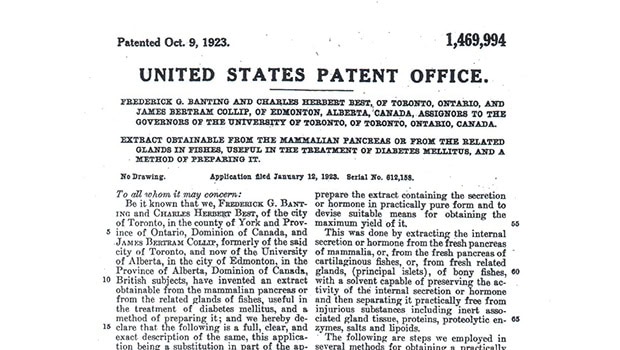Selling a Lifetime of Insulin for $3
The patent on how to make insulin was sold by its inventors for $1 each and supplied royalty-free to pharmaceutical companies worldwide

![]() As if balancing blood sugar levels was not hard enough, people affected by Type 1 also must balance their checkbooks as they try to afford life-sustaining insulin. That stress is aggravated when drug companies make it clear they view insulin as a cash cow, either by raising insulin prices much faster than the cost of production or by engaging in protracted legal battles to keep long-acting insulin formations from going generic.
As if balancing blood sugar levels was not hard enough, people affected by Type 1 also must balance their checkbooks as they try to afford life-sustaining insulin. That stress is aggravated when drug companies make it clear they view insulin as a cash cow, either by raising insulin prices much faster than the cost of production or by engaging in protracted legal battles to keep long-acting insulin formations from going generic.
![]() It didn’t start that way. In fact, the first “sale” of insulin was for just $3 (Canadian), not for a vial, but the very intellectual property of the drug itself. Frederick Banting, Charles Best, and James Collip, the team that first discovered and refined insulin therapy, agreed to receive $1 each in exchange for giving their patent rights to the Board of Governors of the University of Toronto in 1923.
It didn’t start that way. In fact, the first “sale” of insulin was for just $3 (Canadian), not for a vial, but the very intellectual property of the drug itself. Frederick Banting, Charles Best, and James Collip, the team that first discovered and refined insulin therapy, agreed to receive $1 each in exchange for giving their patent rights to the Board of Governors of the University of Toronto in 1923.
This was a bold move, and not without controversy at the time, according to an article posted by the University of Toronto Centre for Innovation Law and Policy. At the turn of the 20th century, it was considered beneath scientists and universities to patent medical innovation at all. However, Banting and company believed that they needed to patent their formulation of insulin to stop pharmaceutical companies from rushing to patent an inferior, less potent form of the drug. The university immediately gave pharmaceutical companies the right to manufacture insulin, royalty-free, and to improve upon the formulation and patent any subsequent improvements.
This may seem like a move that lets the genie out of the bottle, but it’s important to put it into historical context. Mass producing insulin was an incredibly difficult process at the time, and fraught with peril. The original team had trouble recreating the process to make uniformly potent insulin, and at one point it was even feared that they had lost the ability to do the process at all. Meanwhile, they knew this drug was a matter of life and death for thousands of children who were otherwise dying from Type 1. In such circumstances, it seems to make sense that the best action would be to get the drug in the hands of those who could best manufacture the drug on a large scale.
It worked, as within two years, Eli Lilly and Company was able to produce 60 million vials of insulin, according to Dr. Irl Hirsch, a professor of medicine at the University of Washington School of Medicine (as told to health blogger David Mendosa).
It wasn’t long before drug companies had figured out a way to turn a good profit on insulin, even by possibly illegal means. By 1941, Eli Lilly and Company and two other pharmaceutical companies were indicted for an alleged insulin price-fixing scheme at the time, according to a Chicago-Tribune article; it was a charge that Lilly would settle in a “no contest” agreement.
The price of insulin began to climb sharply once drug companies devised how to make synthetic insulin in the late seventies, and there has been little relief since that time. It is now a billion-dollar industry. Unfortunately, as the legal battles over long-acting insulin formulations demonstrate, it will be difficult in the free market to bring insulin prices back in line with the first altruistic principles that Banting and company demonstrated when they sold their idea of insulin for a dollar apiece. One can only hope that those behind future diabetes breakthroughs take a similar open-source attitude to their discoveries as the creators of insulin therapy did*.
*To read about a movement that seems to be following this open source ideology, go to http://insulinnation.com/devices/meters-and-cgms/diabetes-hacker/ or follow the CGM in the Cloud movement at https://www.facebook.com/groups/cgminthecloud/.